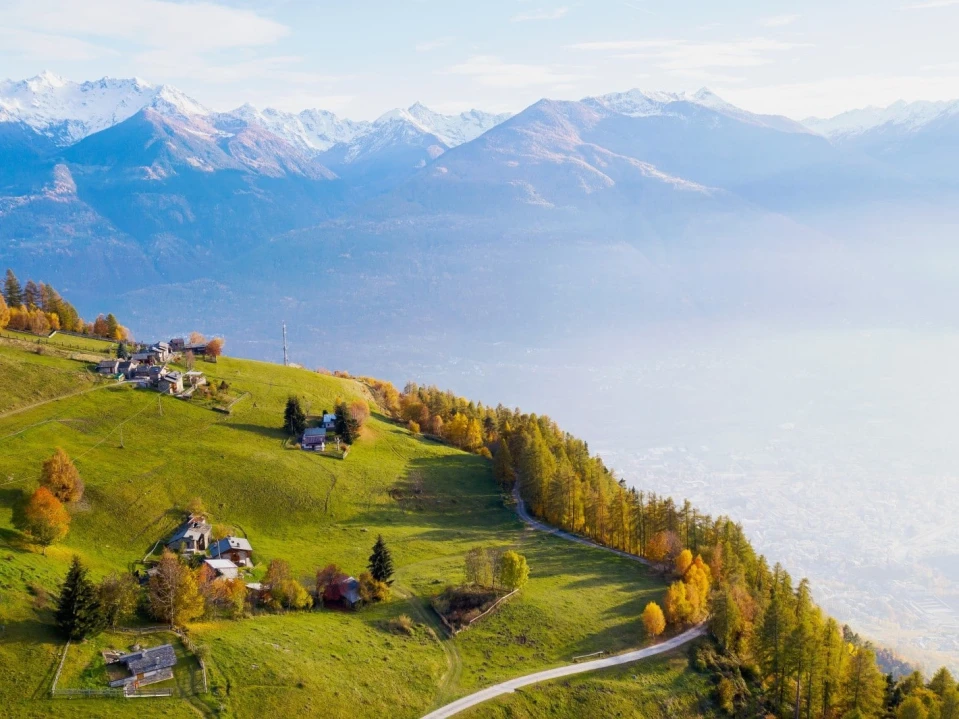The Valtellina is an alpine area in Lombardy that stretches from the Swiss canton of Grisons to Lake Como, nestled between the Western Rhaetian Alps and the Bergamasque Alps. A welcoming land rich in ancient traditions, the Valtellina is the ideal destination for those who love experiencing the mountains in every season.
However, this territory also offers a rich historical, artistic, and architectural heritage, with churches, palaces, and castles that testify to its illustrious past as a crossroads for Europe. Today, the Valtellina is a highly sought-after destination in winter due to its stunning ski resorts, but also in summer, when it becomes the perfect spot for outdoor activities.
This valley is considered a true "open-air gym," as it offers a variety of activities that cater to all its visitors. The green of its pristine nature is accompanied by peaks that rise up to 4,000 meters and small villages with an ancient history. In winter, approximately 400 km of alpine ski slopes and over 200 km dedicated to cross-country skiing attract many winter sports enthusiasts, while in summer, it is an ideal destination for those who enjoy historical and natural itineraries, as well as cycling and mountain biking.
More than half of the Valtellina territory is covered by parks and nature reserves. Specifically, it hosts the Lombardy section of the Stelvio National Park, the largest in the Alpine range, and the Orobie Valtellinesi Regional Park. In addition, there are seven natural reserves: the Val di Mello Nature Reserve, the Postalesio Pyramids, the Bosco dei Bordighi, the Paluaccio di Oga, the Pian di Gembro in Aprica, the Pian di Spagna, and the Park of the Marmitte dei Giganti in Valchiavenna. Along with its natural and cultural heritage, the region is also rich in gastronomic offerings. This area is home to many local producers and breeders, allowing visitors to discover excellent local products such as bresaola, typical cheeses (Bitto, Casera), pizzoccheri, and apples.
Stretching over 200 km, the Valtellina encompasses a vast and diverse landscape. Valtellina is known for its prominent ski resorts, thermal centers, and numerous mountain villages that have preserved their traditional charm.
Stelvio National Park
With its 130,700 hectares, Stelvio National Park is the largest in the Alpine range, covering both Lombardy and Trentino Alto Adige regions, and also one of the oldest parks in Italy. Most of the park lies above 2,000 meters, reaching its highest point at the summit of Ortles, which stands at 3,905 meters. The park includes 23 municipalities, with 10 in Lombardy and 13 in the provinces of Trento and Bolzano. The park boasts 1,500 km of trails, allowing visitors to explore the area's flora and fauna.
In the Lombardy section, you can find vast coniferous forests at lower altitudes, while as you ascend, there are alpine meadows, rocky scree, snowfields, and glaciers. The park is also home to numerous sites that were the backdrop for the battles of the Great War, and there are several routes dedicated to discovering the events of the so-called "White War." As for wildlife, the region is home to foxes, ermine, marmots, as well as deer, roe deer, chamois, and ibex.
Orobie Valtellinesi Park
The Orobie Valtellinesi Regional Park extends along the northern side of the Orobie Alps, straddling the provinces of Sondrio, Lecco, Bergamo, and Brescia. Covering about 50 square kilometers, the park includes fourteen valleys, with the main goal of preserving its remarkable biodiversity. At lower altitudes, you can find forests of conifers and broadleaf trees, while higher up, alpine meadows, gravel fields, and snow hollows appear.
The symbol of the park is the capercaillie, which still finds suitable breeding sites here, while along the trails, you may also encounter roe deer, chamois, and ibex. Well-preserved coniferous forests serve as habitats for the black woodpecker, owls, and martens. The park is also known for producing typical products, such as Bitto cheese made from the milk of Alpine Brown cows, and ricotta, known as maschèrpa. Additionally, high-altitude honey is produced above 1,000 meters.
In the Valtellina, you will find numerous hiking trails to explore on foot or by mountain bike, as well as gastronomic, historical, and religious itineraries. Some trails are simple and suitable for those with little experience or for families with children, while others are multi-day routes that pass through various refuges and some of the most scenic peaks in the Alps.
Those interested in an educational and naturalistic route can visit the Eco-Faunal Observatory in Aprica. The observatory covers an area of about 25 hectares, where you can admire the animals typical of the Orobie Valtellinesi Regional Park. This is certainly an excursion for everyone, but especially for children. The most famous hiking route in the Orobie Valtellinesi Park is the Gran Via delle Orobie, which spans 130 km at an average altitude of 1,800 meters, connecting Delebio to Aprica. For the more experienced, the Alta Via della Valmalenco offers an eight-stage route totaling 110 km. This itinerary traverses the entire Valmalenco mountain chain, passing through the Disgrazia, Bernina, and Scalino groups.
Finally, the Valtellina is also crossed by the Sentiero Italia, one of the longest trekking routes in the world, which runs through both the Apennines and the Alps. For a gastronomic itinerary, the Via dei Terrazzamenti is recommended, which passes through the terraced vineyards and villages of the Valtellina. If you wish to spend your days immersed in history and nature, there are numerous trails that retrace the areas of the First World War between the Stelvio Pass and the Ablès Pass in Valfurva.




